Liverpool John Moores University Business Law: Negligence Case Study
VerifiedAdded on 2023/04/07
|11
|2432
|113
Case Study
AI Summary
This case study analyzes a business law scenario involving negligence, personal injury, and wrongful death. The case revolves around Sampson, who suffered multiple injuries due to various incidents, including an abseiling accident caused by Matt's negligence. The analysis explores the concept of negligence, including gross and comparative negligence, and examines the elements required to prove a negligence claim, such as duty of care, breach, causation, and damages. It discusses relevant legal principles, including contributory negligence, the last clear chance doctrine, and the remedies available to the plaintiff, such as special, general, punitive, and aggravated damages. The case also considers the impact of subsequent events, such as the falling tree branch, Brian's crash, and Sampson's suicide, on Matt's liability. The analysis references key legal precedents, including Smoldon v Whitworth & Nolan, Darnley v Croydon NHST, and Haynes v Harwood, to support its arguments. Ultimately, the study aims to determine the extent of Matt's liability for the various injuries and Sampson's death, considering the principles of tort law and the application of legal remedies.
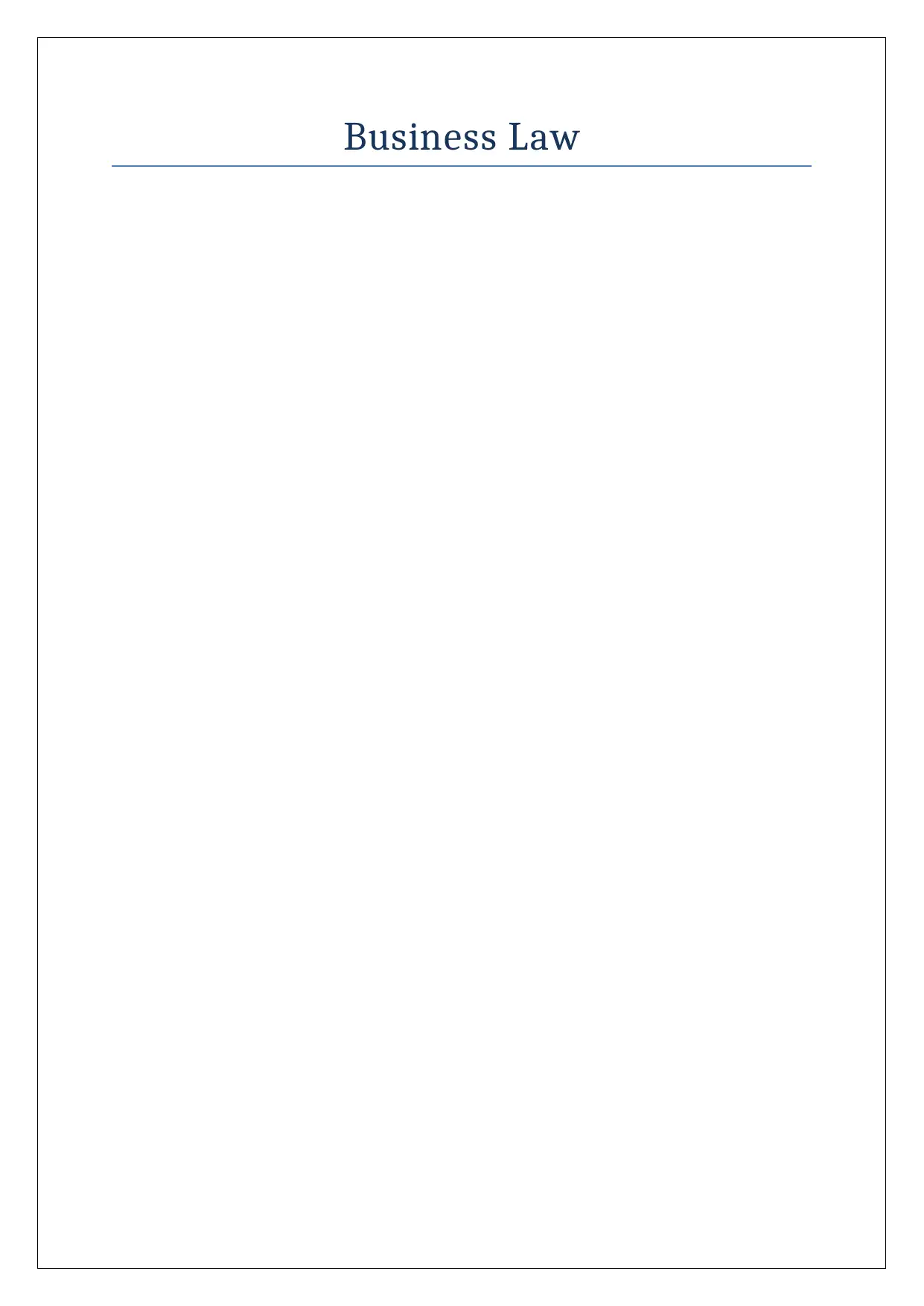
Business Law
Paraphrase This Document
Need a fresh take? Get an instant paraphrase of this document with our AI Paraphraser
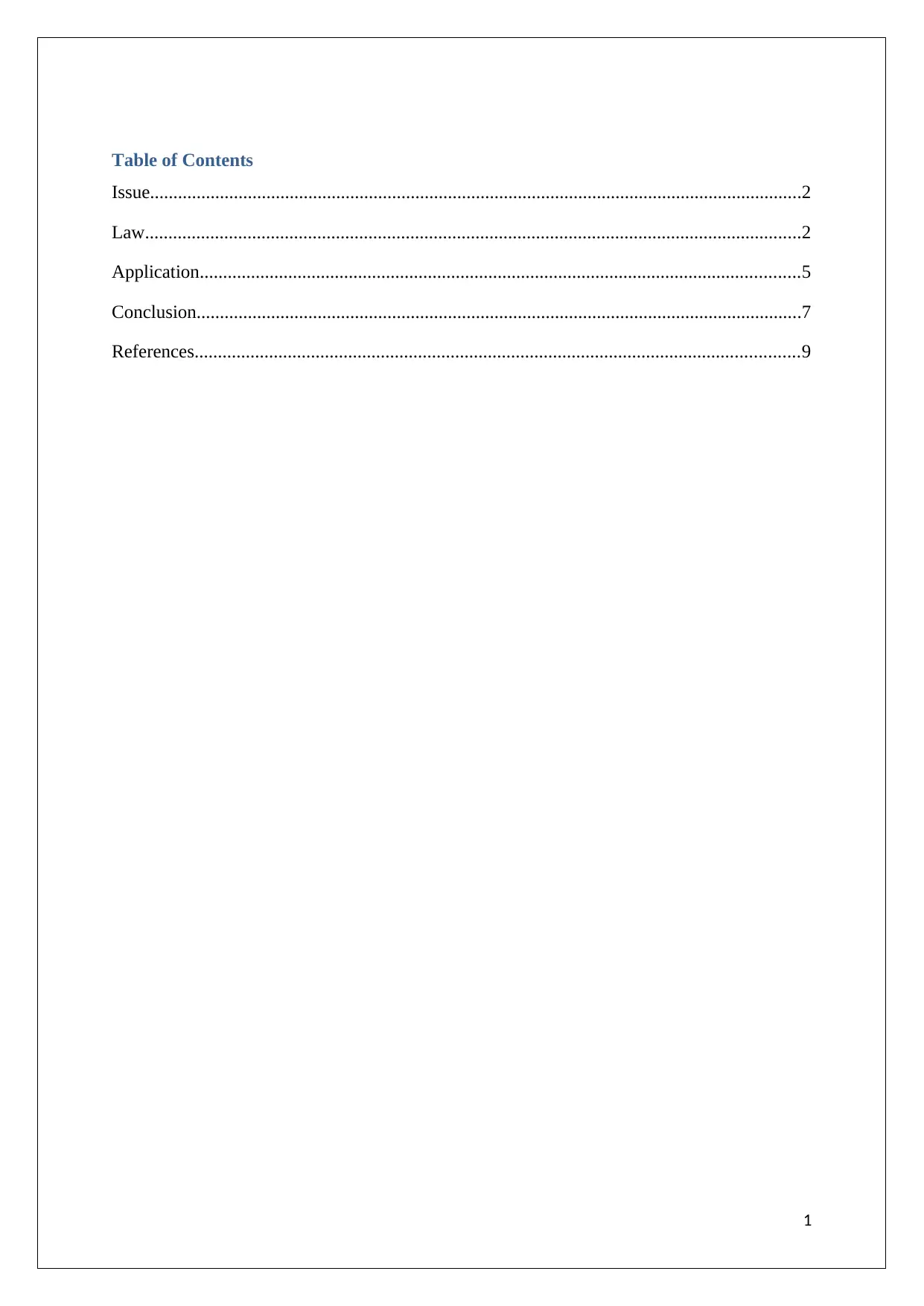
Table of Contents
Issue............................................................................................................................................2
Law.............................................................................................................................................2
Application.................................................................................................................................5
Conclusion..................................................................................................................................7
References..................................................................................................................................9
1
Issue............................................................................................................................................2
Law.............................................................................................................................................2
Application.................................................................................................................................5
Conclusion..................................................................................................................................7
References..................................................................................................................................9
1
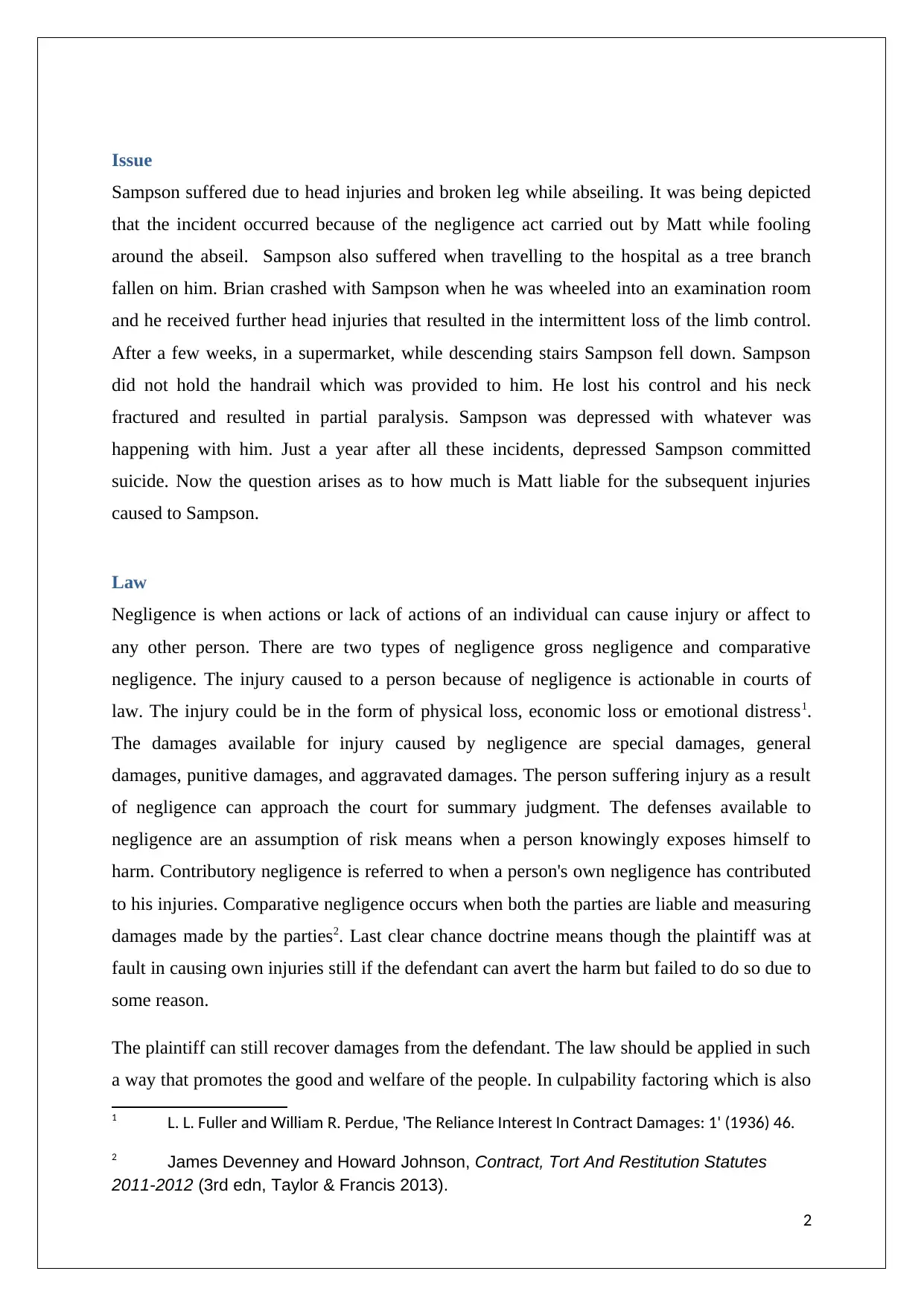
Issue
Sampson suffered due to head injuries and broken leg while abseiling. It was being depicted
that the incident occurred because of the negligence act carried out by Matt while fooling
around the abseil. Sampson also suffered when travelling to the hospital as a tree branch
fallen on him. Brian crashed with Sampson when he was wheeled into an examination room
and he received further head injuries that resulted in the intermittent loss of the limb control.
After a few weeks, in a supermarket, while descending stairs Sampson fell down. Sampson
did not hold the handrail which was provided to him. He lost his control and his neck
fractured and resulted in partial paralysis. Sampson was depressed with whatever was
happening with him. Just a year after all these incidents, depressed Sampson committed
suicide. Now the question arises as to how much is Matt liable for the subsequent injuries
caused to Sampson.
Law
Negligence is when actions or lack of actions of an individual can cause injury or affect to
any other person. There are two types of negligence gross negligence and comparative
negligence. The injury caused to a person because of negligence is actionable in courts of
law. The injury could be in the form of physical loss, economic loss or emotional distress1.
The damages available for injury caused by negligence are special damages, general
damages, punitive damages, and aggravated damages. The person suffering injury as a result
of negligence can approach the court for summary judgment. The defenses available to
negligence are an assumption of risk means when a person knowingly exposes himself to
harm. Contributory negligence is referred to when a person's own negligence has contributed
to his injuries. Comparative negligence occurs when both the parties are liable and measuring
damages made by the parties2. Last clear chance doctrine means though the plaintiff was at
fault in causing own injuries still if the defendant can avert the harm but failed to do so due to
some reason.
The plaintiff can still recover damages from the defendant. The law should be applied in such
a way that promotes the good and welfare of the people. In culpability factoring which is also
1 L. L. Fuller and William R. Perdue, 'The Reliance Interest In Contract Damages: 1' (1936) 46.
2 James Devenney and Howard Johnson, Contract, Tort And Restitution Statutes
2011-2012 (3rd edn, Taylor & Francis 2013).
2
Sampson suffered due to head injuries and broken leg while abseiling. It was being depicted
that the incident occurred because of the negligence act carried out by Matt while fooling
around the abseil. Sampson also suffered when travelling to the hospital as a tree branch
fallen on him. Brian crashed with Sampson when he was wheeled into an examination room
and he received further head injuries that resulted in the intermittent loss of the limb control.
After a few weeks, in a supermarket, while descending stairs Sampson fell down. Sampson
did not hold the handrail which was provided to him. He lost his control and his neck
fractured and resulted in partial paralysis. Sampson was depressed with whatever was
happening with him. Just a year after all these incidents, depressed Sampson committed
suicide. Now the question arises as to how much is Matt liable for the subsequent injuries
caused to Sampson.
Law
Negligence is when actions or lack of actions of an individual can cause injury or affect to
any other person. There are two types of negligence gross negligence and comparative
negligence. The injury caused to a person because of negligence is actionable in courts of
law. The injury could be in the form of physical loss, economic loss or emotional distress1.
The damages available for injury caused by negligence are special damages, general
damages, punitive damages, and aggravated damages. The person suffering injury as a result
of negligence can approach the court for summary judgment. The defenses available to
negligence are an assumption of risk means when a person knowingly exposes himself to
harm. Contributory negligence is referred to when a person's own negligence has contributed
to his injuries. Comparative negligence occurs when both the parties are liable and measuring
damages made by the parties2. Last clear chance doctrine means though the plaintiff was at
fault in causing own injuries still if the defendant can avert the harm but failed to do so due to
some reason.
The plaintiff can still recover damages from the defendant. The law should be applied in such
a way that promotes the good and welfare of the people. In culpability factoring which is also
1 L. L. Fuller and William R. Perdue, 'The Reliance Interest In Contract Damages: 1' (1936) 46.
2 James Devenney and Howard Johnson, Contract, Tort And Restitution Statutes
2011-2012 (3rd edn, Taylor & Francis 2013).
2
⊘ This is a preview!⊘
Do you want full access?
Subscribe today to unlock all pages.

Trusted by 1+ million students worldwide
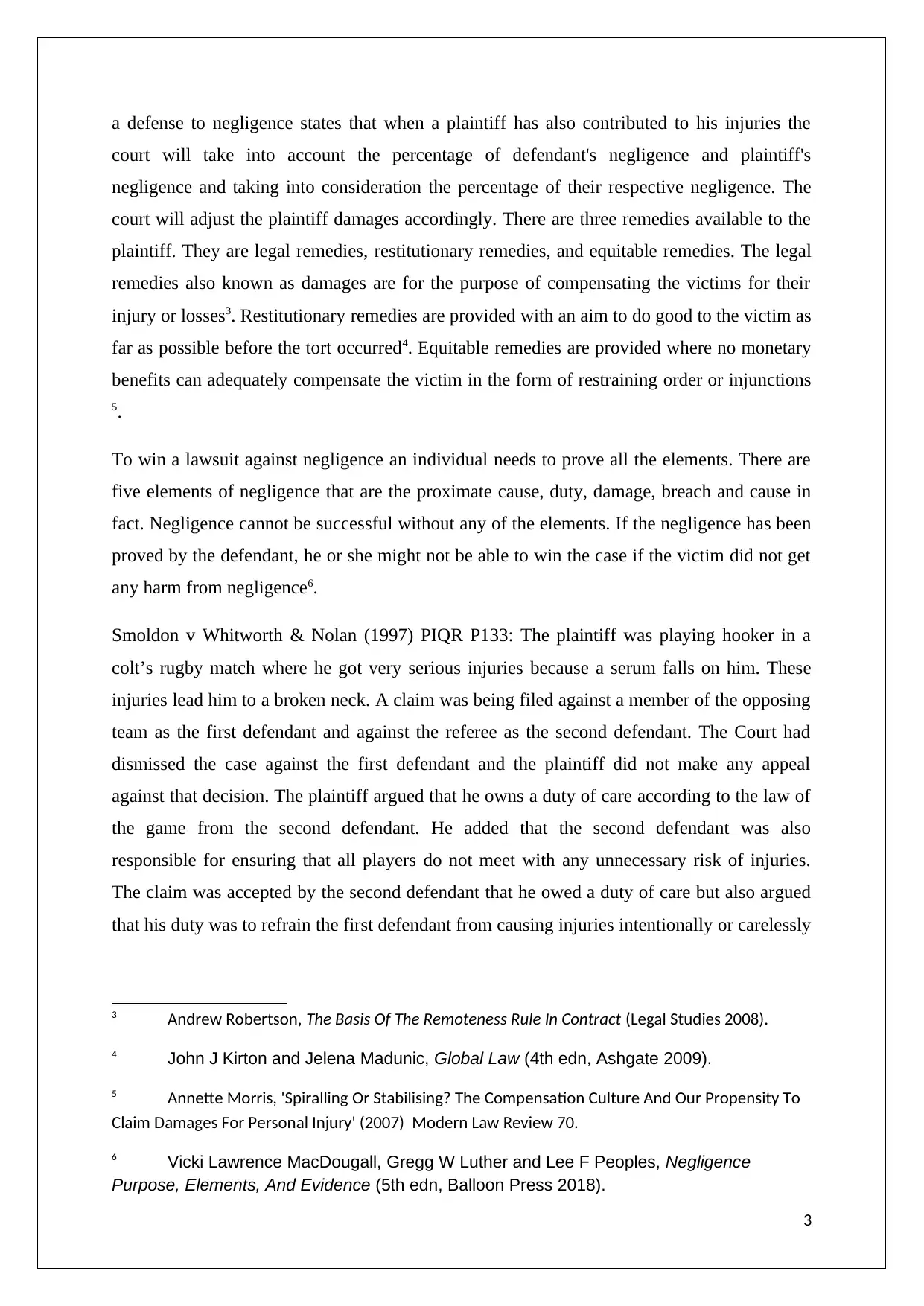
a defense to negligence states that when a plaintiff has also contributed to his injuries the
court will take into account the percentage of defendant's negligence and plaintiff's
negligence and taking into consideration the percentage of their respective negligence. The
court will adjust the plaintiff damages accordingly. There are three remedies available to the
plaintiff. They are legal remedies, restitutionary remedies, and equitable remedies. The legal
remedies also known as damages are for the purpose of compensating the victims for their
injury or losses3. Restitutionary remedies are provided with an aim to do good to the victim as
far as possible before the tort occurred4. Equitable remedies are provided where no monetary
benefits can adequately compensate the victim in the form of restraining order or injunctions
5.
To win a lawsuit against negligence an individual needs to prove all the elements. There are
five elements of negligence that are the proximate cause, duty, damage, breach and cause in
fact. Negligence cannot be successful without any of the elements. If the negligence has been
proved by the defendant, he or she might not be able to win the case if the victim did not get
any harm from negligence6.
Smoldon v Whitworth & Nolan (1997) PIQR P133: The plaintiff was playing hooker in a
colt’s rugby match where he got very serious injuries because a serum falls on him. These
injuries lead him to a broken neck. A claim was being filed against a member of the opposing
team as the first defendant and against the referee as the second defendant. The Court had
dismissed the case against the first defendant and the plaintiff did not make any appeal
against that decision. The plaintiff argued that he owns a duty of care according to the law of
the game from the second defendant. He added that the second defendant was also
responsible for ensuring that all players do not meet with any unnecessary risk of injuries.
The claim was accepted by the second defendant that he owed a duty of care but also argued
that his duty was to refrain the first defendant from causing injuries intentionally or carelessly
3 Andrew Robertson, The Basis Of The Remoteness Rule In Contract (Legal Studies 2008).
4 John J Kirton and Jelena Madunic, Global Law (4th edn, Ashgate 2009).
5 Annette Morris, 'Spiralling Or Stabilising? The Compensation Culture And Our Propensity To
Claim Damages For Personal Injury' (2007) Modern Law Review 70.
6 Vicki Lawrence MacDougall, Gregg W Luther and Lee F Peoples, Negligence
Purpose, Elements, And Evidence (5th edn, Balloon Press 2018).
3
court will take into account the percentage of defendant's negligence and plaintiff's
negligence and taking into consideration the percentage of their respective negligence. The
court will adjust the plaintiff damages accordingly. There are three remedies available to the
plaintiff. They are legal remedies, restitutionary remedies, and equitable remedies. The legal
remedies also known as damages are for the purpose of compensating the victims for their
injury or losses3. Restitutionary remedies are provided with an aim to do good to the victim as
far as possible before the tort occurred4. Equitable remedies are provided where no monetary
benefits can adequately compensate the victim in the form of restraining order or injunctions
5.
To win a lawsuit against negligence an individual needs to prove all the elements. There are
five elements of negligence that are the proximate cause, duty, damage, breach and cause in
fact. Negligence cannot be successful without any of the elements. If the negligence has been
proved by the defendant, he or she might not be able to win the case if the victim did not get
any harm from negligence6.
Smoldon v Whitworth & Nolan (1997) PIQR P133: The plaintiff was playing hooker in a
colt’s rugby match where he got very serious injuries because a serum falls on him. These
injuries lead him to a broken neck. A claim was being filed against a member of the opposing
team as the first defendant and against the referee as the second defendant. The Court had
dismissed the case against the first defendant and the plaintiff did not make any appeal
against that decision. The plaintiff argued that he owns a duty of care according to the law of
the game from the second defendant. He added that the second defendant was also
responsible for ensuring that all players do not meet with any unnecessary risk of injuries.
The claim was accepted by the second defendant that he owed a duty of care but also argued
that his duty was to refrain the first defendant from causing injuries intentionally or carelessly
3 Andrew Robertson, The Basis Of The Remoteness Rule In Contract (Legal Studies 2008).
4 John J Kirton and Jelena Madunic, Global Law (4th edn, Ashgate 2009).
5 Annette Morris, 'Spiralling Or Stabilising? The Compensation Culture And Our Propensity To
Claim Damages For Personal Injury' (2007) Modern Law Review 70.
6 Vicki Lawrence MacDougall, Gregg W Luther and Lee F Peoples, Negligence
Purpose, Elements, And Evidence (5th edn, Balloon Press 2018).
3
Paraphrase This Document
Need a fresh take? Get an instant paraphrase of this document with our AI Paraphraser
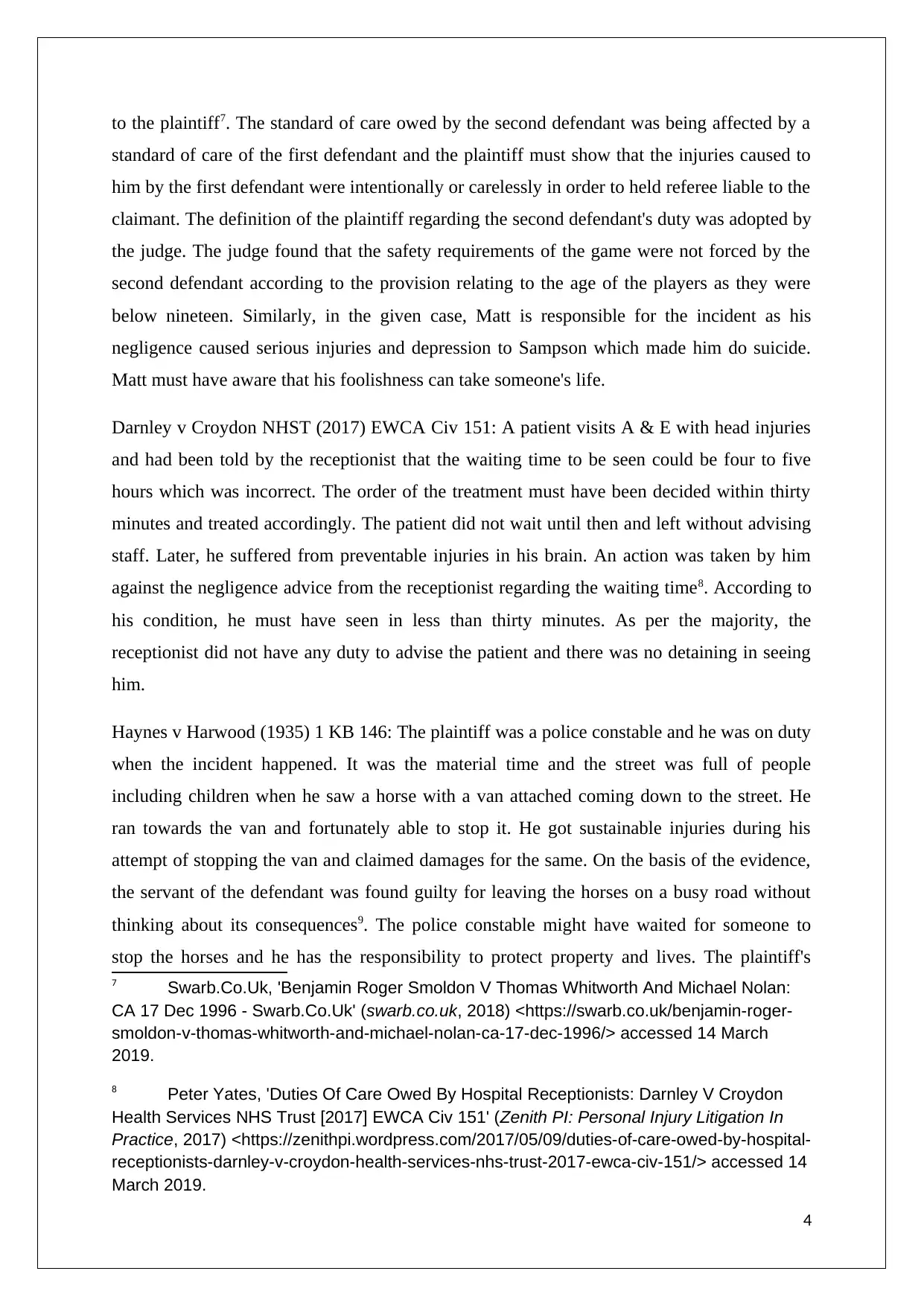
to the plaintiff7. The standard of care owed by the second defendant was being affected by a
standard of care of the first defendant and the plaintiff must show that the injuries caused to
him by the first defendant were intentionally or carelessly in order to held referee liable to the
claimant. The definition of the plaintiff regarding the second defendant's duty was adopted by
the judge. The judge found that the safety requirements of the game were not forced by the
second defendant according to the provision relating to the age of the players as they were
below nineteen. Similarly, in the given case, Matt is responsible for the incident as his
negligence caused serious injuries and depression to Sampson which made him do suicide.
Matt must have aware that his foolishness can take someone's life.
Darnley v Croydon NHST (2017) EWCA Civ 151: A patient visits A & E with head injuries
and had been told by the receptionist that the waiting time to be seen could be four to five
hours which was incorrect. The order of the treatment must have been decided within thirty
minutes and treated accordingly. The patient did not wait until then and left without advising
staff. Later, he suffered from preventable injuries in his brain. An action was taken by him
against the negligence advice from the receptionist regarding the waiting time8. According to
his condition, he must have seen in less than thirty minutes. As per the majority, the
receptionist did not have any duty to advise the patient and there was no detaining in seeing
him.
Haynes v Harwood (1935) 1 KB 146: The plaintiff was a police constable and he was on duty
when the incident happened. It was the material time and the street was full of people
including children when he saw a horse with a van attached coming down to the street. He
ran towards the van and fortunately able to stop it. He got sustainable injuries during his
attempt of stopping the van and claimed damages for the same. On the basis of the evidence,
the servant of the defendant was found guilty for leaving the horses on a busy road without
thinking about its consequences9. The police constable might have waited for someone to
stop the horses and he has the responsibility to protect property and lives. The plaintiff's
7 Swarb.Co.Uk, 'Benjamin Roger Smoldon V Thomas Whitworth And Michael Nolan:
CA 17 Dec 1996 - Swarb.Co.Uk' (swarb.co.uk, 2018) <https://swarb.co.uk/benjamin-roger-
smoldon-v-thomas-whitworth-and-michael-nolan-ca-17-dec-1996/> accessed 14 March
2019.
8 Peter Yates, 'Duties Of Care Owed By Hospital Receptionists: Darnley V Croydon
Health Services NHS Trust [2017] EWCA Civ 151' (Zenith PI: Personal Injury Litigation In
Practice, 2017) <https://zenithpi.wordpress.com/2017/05/09/duties-of-care-owed-by-hospital-
receptionists-darnley-v-croydon-health-services-nhs-trust-2017-ewca-civ-151/> accessed 14
March 2019.
4
standard of care of the first defendant and the plaintiff must show that the injuries caused to
him by the first defendant were intentionally or carelessly in order to held referee liable to the
claimant. The definition of the plaintiff regarding the second defendant's duty was adopted by
the judge. The judge found that the safety requirements of the game were not forced by the
second defendant according to the provision relating to the age of the players as they were
below nineteen. Similarly, in the given case, Matt is responsible for the incident as his
negligence caused serious injuries and depression to Sampson which made him do suicide.
Matt must have aware that his foolishness can take someone's life.
Darnley v Croydon NHST (2017) EWCA Civ 151: A patient visits A & E with head injuries
and had been told by the receptionist that the waiting time to be seen could be four to five
hours which was incorrect. The order of the treatment must have been decided within thirty
minutes and treated accordingly. The patient did not wait until then and left without advising
staff. Later, he suffered from preventable injuries in his brain. An action was taken by him
against the negligence advice from the receptionist regarding the waiting time8. According to
his condition, he must have seen in less than thirty minutes. As per the majority, the
receptionist did not have any duty to advise the patient and there was no detaining in seeing
him.
Haynes v Harwood (1935) 1 KB 146: The plaintiff was a police constable and he was on duty
when the incident happened. It was the material time and the street was full of people
including children when he saw a horse with a van attached coming down to the street. He
ran towards the van and fortunately able to stop it. He got sustainable injuries during his
attempt of stopping the van and claimed damages for the same. On the basis of the evidence,
the servant of the defendant was found guilty for leaving the horses on a busy road without
thinking about its consequences9. The police constable might have waited for someone to
stop the horses and he has the responsibility to protect property and lives. The plaintiff's
7 Swarb.Co.Uk, 'Benjamin Roger Smoldon V Thomas Whitworth And Michael Nolan:
CA 17 Dec 1996 - Swarb.Co.Uk' (swarb.co.uk, 2018) <https://swarb.co.uk/benjamin-roger-
smoldon-v-thomas-whitworth-and-michael-nolan-ca-17-dec-1996/> accessed 14 March
2019.
8 Peter Yates, 'Duties Of Care Owed By Hospital Receptionists: Darnley V Croydon
Health Services NHS Trust [2017] EWCA Civ 151' (Zenith PI: Personal Injury Litigation In
Practice, 2017) <https://zenithpi.wordpress.com/2017/05/09/duties-of-care-owed-by-hospital-
receptionists-darnley-v-croydon-health-services-nhs-trust-2017-ewca-civ-151/> accessed 14
March 2019.
4
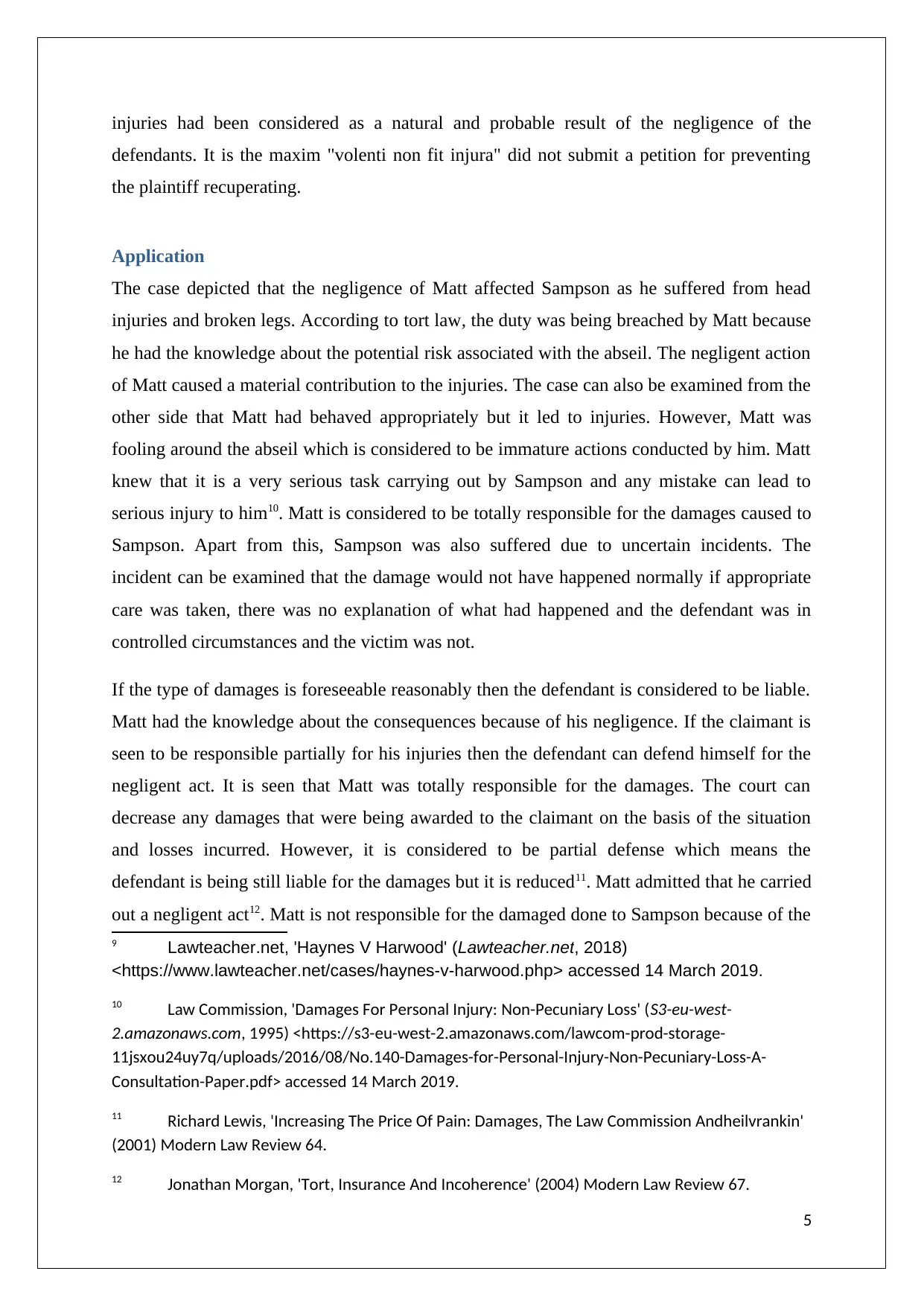
injuries had been considered as a natural and probable result of the negligence of the
defendants. It is the maxim "volenti non fit injura" did not submit a petition for preventing
the plaintiff recuperating.
Application
The case depicted that the negligence of Matt affected Sampson as he suffered from head
injuries and broken legs. According to tort law, the duty was being breached by Matt because
he had the knowledge about the potential risk associated with the abseil. The negligent action
of Matt caused a material contribution to the injuries. The case can also be examined from the
other side that Matt had behaved appropriately but it led to injuries. However, Matt was
fooling around the abseil which is considered to be immature actions conducted by him. Matt
knew that it is a very serious task carrying out by Sampson and any mistake can lead to
serious injury to him10. Matt is considered to be totally responsible for the damages caused to
Sampson. Apart from this, Sampson was also suffered due to uncertain incidents. The
incident can be examined that the damage would not have happened normally if appropriate
care was taken, there was no explanation of what had happened and the defendant was in
controlled circumstances and the victim was not.
If the type of damages is foreseeable reasonably then the defendant is considered to be liable.
Matt had the knowledge about the consequences because of his negligence. If the claimant is
seen to be responsible partially for his injuries then the defendant can defend himself for the
negligent act. It is seen that Matt was totally responsible for the damages. The court can
decrease any damages that were being awarded to the claimant on the basis of the situation
and losses incurred. However, it is considered to be partial defense which means the
defendant is being still liable for the damages but it is reduced11. Matt admitted that he carried
out a negligent act12. Matt is not responsible for the damaged done to Sampson because of the
9 Lawteacher.net, 'Haynes V Harwood' (Lawteacher.net, 2018)
<https://www.lawteacher.net/cases/haynes-v-harwood.php> accessed 14 March 2019.
10 Law Commission, 'Damages For Personal Injury: Non-Pecuniary Loss' (S3-eu-west-
2.amazonaws.com, 1995) <https://s3-eu-west-2.amazonaws.com/lawcom-prod-storage-
11jsxou24uy7q/uploads/2016/08/No.140-Damages-for-Personal-Injury-Non-Pecuniary-Loss-A-
Consultation-Paper.pdf> accessed 14 March 2019.
11 Richard Lewis, 'Increasing The Price Of Pain: Damages, The Law Commission Andheilvrankin'
(2001) Modern Law Review 64.
12 Jonathan Morgan, 'Tort, Insurance And Incoherence' (2004) Modern Law Review 67.
5
defendants. It is the maxim "volenti non fit injura" did not submit a petition for preventing
the plaintiff recuperating.
Application
The case depicted that the negligence of Matt affected Sampson as he suffered from head
injuries and broken legs. According to tort law, the duty was being breached by Matt because
he had the knowledge about the potential risk associated with the abseil. The negligent action
of Matt caused a material contribution to the injuries. The case can also be examined from the
other side that Matt had behaved appropriately but it led to injuries. However, Matt was
fooling around the abseil which is considered to be immature actions conducted by him. Matt
knew that it is a very serious task carrying out by Sampson and any mistake can lead to
serious injury to him10. Matt is considered to be totally responsible for the damages caused to
Sampson. Apart from this, Sampson was also suffered due to uncertain incidents. The
incident can be examined that the damage would not have happened normally if appropriate
care was taken, there was no explanation of what had happened and the defendant was in
controlled circumstances and the victim was not.
If the type of damages is foreseeable reasonably then the defendant is considered to be liable.
Matt had the knowledge about the consequences because of his negligence. If the claimant is
seen to be responsible partially for his injuries then the defendant can defend himself for the
negligent act. It is seen that Matt was totally responsible for the damages. The court can
decrease any damages that were being awarded to the claimant on the basis of the situation
and losses incurred. However, it is considered to be partial defense which means the
defendant is being still liable for the damages but it is reduced11. Matt admitted that he carried
out a negligent act12. Matt is not responsible for the damaged done to Sampson because of the
9 Lawteacher.net, 'Haynes V Harwood' (Lawteacher.net, 2018)
<https://www.lawteacher.net/cases/haynes-v-harwood.php> accessed 14 March 2019.
10 Law Commission, 'Damages For Personal Injury: Non-Pecuniary Loss' (S3-eu-west-
2.amazonaws.com, 1995) <https://s3-eu-west-2.amazonaws.com/lawcom-prod-storage-
11jsxou24uy7q/uploads/2016/08/No.140-Damages-for-Personal-Injury-Non-Pecuniary-Loss-A-
Consultation-Paper.pdf> accessed 14 March 2019.
11 Richard Lewis, 'Increasing The Price Of Pain: Damages, The Law Commission Andheilvrankin'
(2001) Modern Law Review 64.
12 Jonathan Morgan, 'Tort, Insurance And Incoherence' (2004) Modern Law Review 67.
5
⊘ This is a preview!⊘
Do you want full access?
Subscribe today to unlock all pages.

Trusted by 1+ million students worldwide
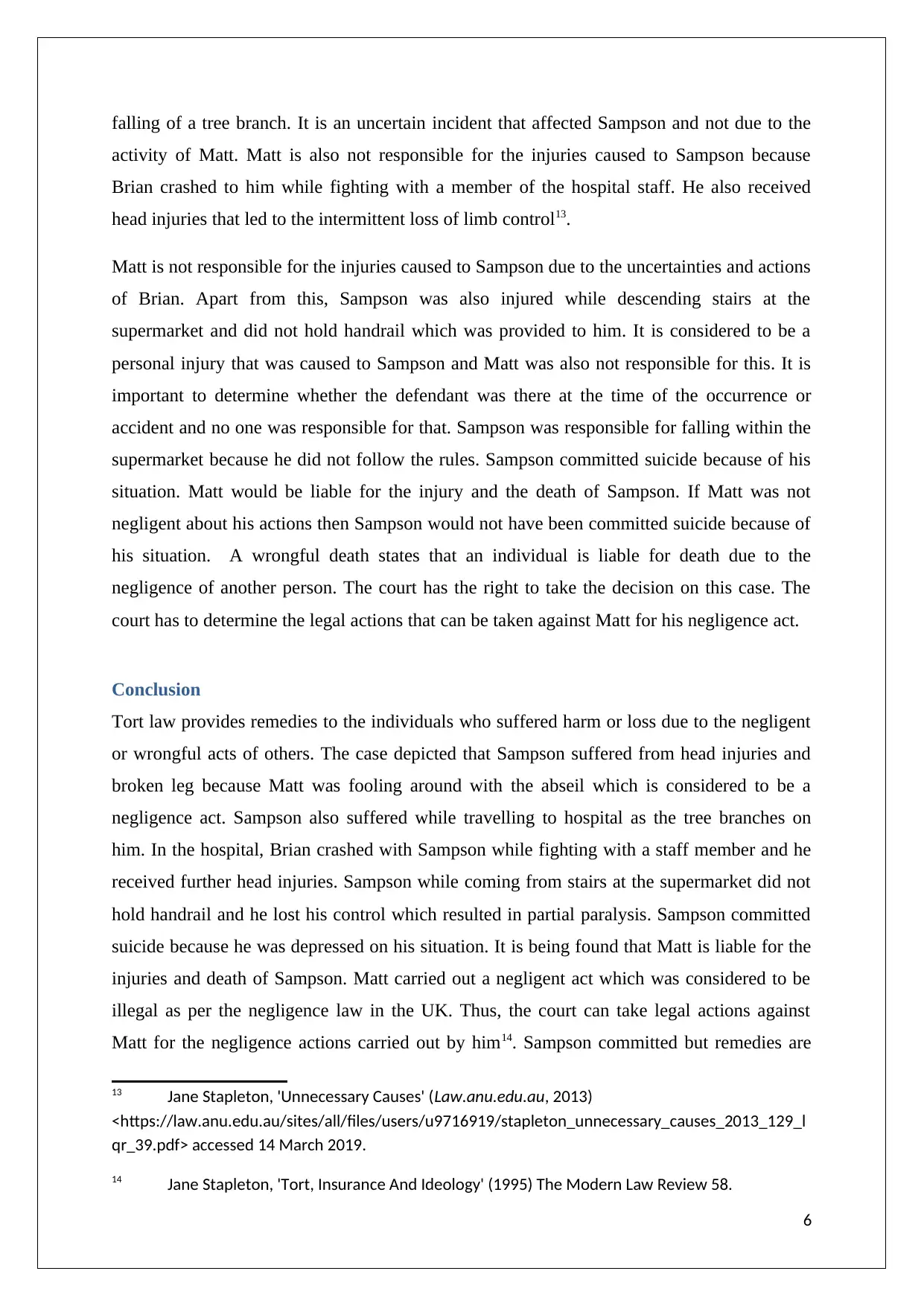
falling of a tree branch. It is an uncertain incident that affected Sampson and not due to the
activity of Matt. Matt is also not responsible for the injuries caused to Sampson because
Brian crashed to him while fighting with a member of the hospital staff. He also received
head injuries that led to the intermittent loss of limb control13.
Matt is not responsible for the injuries caused to Sampson due to the uncertainties and actions
of Brian. Apart from this, Sampson was also injured while descending stairs at the
supermarket and did not hold handrail which was provided to him. It is considered to be a
personal injury that was caused to Sampson and Matt was also not responsible for this. It is
important to determine whether the defendant was there at the time of the occurrence or
accident and no one was responsible for that. Sampson was responsible for falling within the
supermarket because he did not follow the rules. Sampson committed suicide because of his
situation. Matt would be liable for the injury and the death of Sampson. If Matt was not
negligent about his actions then Sampson would not have been committed suicide because of
his situation. A wrongful death states that an individual is liable for death due to the
negligence of another person. The court has the right to take the decision on this case. The
court has to determine the legal actions that can be taken against Matt for his negligence act.
Conclusion
Tort law provides remedies to the individuals who suffered harm or loss due to the negligent
or wrongful acts of others. The case depicted that Sampson suffered from head injuries and
broken leg because Matt was fooling around with the abseil which is considered to be a
negligence act. Sampson also suffered while travelling to hospital as the tree branches on
him. In the hospital, Brian crashed with Sampson while fighting with a staff member and he
received further head injuries. Sampson while coming from stairs at the supermarket did not
hold handrail and he lost his control which resulted in partial paralysis. Sampson committed
suicide because he was depressed on his situation. It is being found that Matt is liable for the
injuries and death of Sampson. Matt carried out a negligent act which was considered to be
illegal as per the negligence law in the UK. Thus, the court can take legal actions against
Matt for the negligence actions carried out by him14. Sampson committed but remedies are
13 Jane Stapleton, 'Unnecessary Causes' (Law.anu.edu.au, 2013)
<https://law.anu.edu.au/sites/all/files/users/u9716919/stapleton_unnecessary_causes_2013_129_l
qr_39.pdf> accessed 14 March 2019.
14 Jane Stapleton, 'Tort, Insurance And Ideology' (1995) The Modern Law Review 58.
6
activity of Matt. Matt is also not responsible for the injuries caused to Sampson because
Brian crashed to him while fighting with a member of the hospital staff. He also received
head injuries that led to the intermittent loss of limb control13.
Matt is not responsible for the injuries caused to Sampson due to the uncertainties and actions
of Brian. Apart from this, Sampson was also injured while descending stairs at the
supermarket and did not hold handrail which was provided to him. It is considered to be a
personal injury that was caused to Sampson and Matt was also not responsible for this. It is
important to determine whether the defendant was there at the time of the occurrence or
accident and no one was responsible for that. Sampson was responsible for falling within the
supermarket because he did not follow the rules. Sampson committed suicide because of his
situation. Matt would be liable for the injury and the death of Sampson. If Matt was not
negligent about his actions then Sampson would not have been committed suicide because of
his situation. A wrongful death states that an individual is liable for death due to the
negligence of another person. The court has the right to take the decision on this case. The
court has to determine the legal actions that can be taken against Matt for his negligence act.
Conclusion
Tort law provides remedies to the individuals who suffered harm or loss due to the negligent
or wrongful acts of others. The case depicted that Sampson suffered from head injuries and
broken leg because Matt was fooling around with the abseil which is considered to be a
negligence act. Sampson also suffered while travelling to hospital as the tree branches on
him. In the hospital, Brian crashed with Sampson while fighting with a staff member and he
received further head injuries. Sampson while coming from stairs at the supermarket did not
hold handrail and he lost his control which resulted in partial paralysis. Sampson committed
suicide because he was depressed on his situation. It is being found that Matt is liable for the
injuries and death of Sampson. Matt carried out a negligent act which was considered to be
illegal as per the negligence law in the UK. Thus, the court can take legal actions against
Matt for the negligence actions carried out by him14. Sampson committed but remedies are
13 Jane Stapleton, 'Unnecessary Causes' (Law.anu.edu.au, 2013)
<https://law.anu.edu.au/sites/all/files/users/u9716919/stapleton_unnecessary_causes_2013_129_l
qr_39.pdf> accessed 14 March 2019.
14 Jane Stapleton, 'Tort, Insurance And Ideology' (1995) The Modern Law Review 58.
6
Paraphrase This Document
Need a fresh take? Get an instant paraphrase of this document with our AI Paraphraser
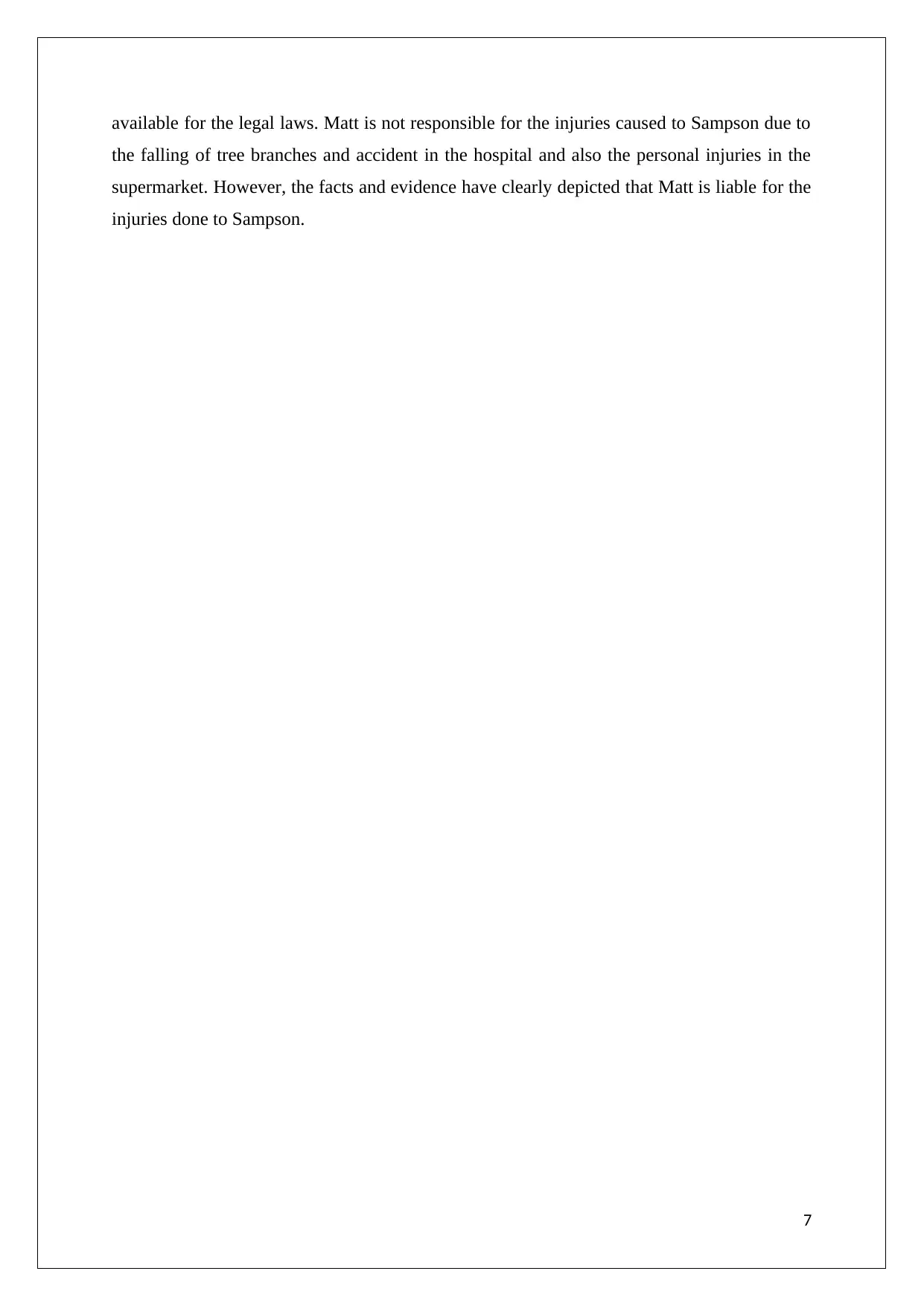
available for the legal laws. Matt is not responsible for the injuries caused to Sampson due to
the falling of tree branches and accident in the hospital and also the personal injuries in the
supermarket. However, the facts and evidence have clearly depicted that Matt is liable for the
injuries done to Sampson.
7
the falling of tree branches and accident in the hospital and also the personal injuries in the
supermarket. However, the facts and evidence have clearly depicted that Matt is liable for the
injuries done to Sampson.
7
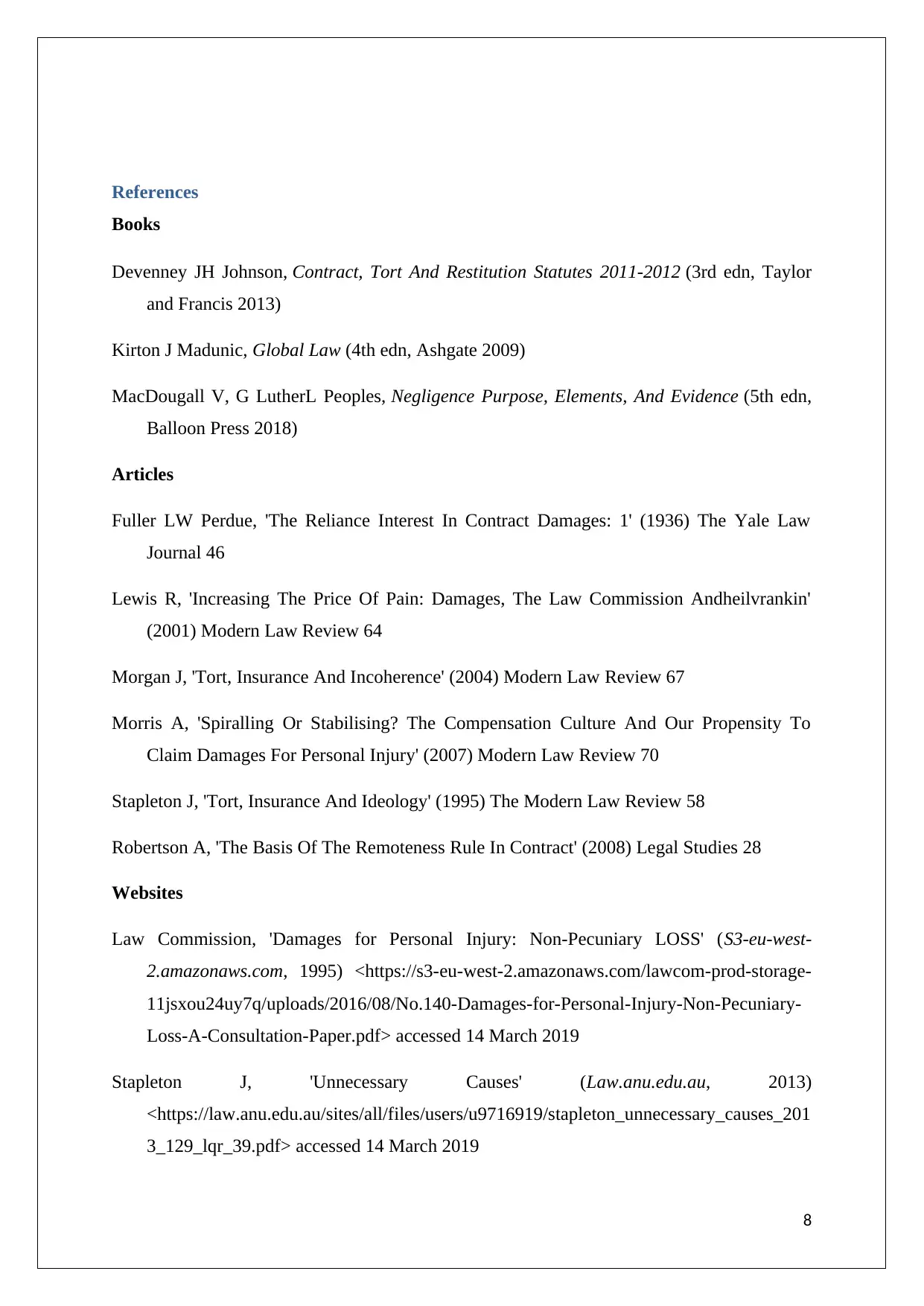
References
Books
Devenney JH Johnson, Contract, Tort And Restitution Statutes 2011-2012 (3rd edn, Taylor
and Francis 2013)
Kirton J Madunic, Global Law (4th edn, Ashgate 2009)
MacDougall V, G LutherL Peoples, Negligence Purpose, Elements, And Evidence (5th edn,
Balloon Press 2018)
Articles
Fuller LW Perdue, 'The Reliance Interest In Contract Damages: 1' (1936) The Yale Law
Journal 46
Lewis R, 'Increasing The Price Of Pain: Damages, The Law Commission Andheilvrankin'
(2001) Modern Law Review 64
Morgan J, 'Tort, Insurance And Incoherence' (2004) Modern Law Review 67
Morris A, 'Spiralling Or Stabilising? The Compensation Culture And Our Propensity To
Claim Damages For Personal Injury' (2007) Modern Law Review 70
Stapleton J, 'Tort, Insurance And Ideology' (1995) The Modern Law Review 58
Robertson A, 'The Basis Of The Remoteness Rule In Contract' (2008) Legal Studies 28
Websites
Law Commission, 'Damages for Personal Injury: Non-Pecuniary LOSS' (S3-eu-west-
2.amazonaws.com, 1995) <https://s3-eu-west-2.amazonaws.com/lawcom-prod-storage-
11jsxou24uy7q/uploads/2016/08/No.140-Damages-for-Personal-Injury-Non-Pecuniary-
Loss-A-Consultation-Paper.pdf> accessed 14 March 2019
Stapleton J, 'Unnecessary Causes' (Law.anu.edu.au, 2013)
<https://law.anu.edu.au/sites/all/files/users/u9716919/stapleton_unnecessary_causes_201
3_129_lqr_39.pdf> accessed 14 March 2019
8
Books
Devenney JH Johnson, Contract, Tort And Restitution Statutes 2011-2012 (3rd edn, Taylor
and Francis 2013)
Kirton J Madunic, Global Law (4th edn, Ashgate 2009)
MacDougall V, G LutherL Peoples, Negligence Purpose, Elements, And Evidence (5th edn,
Balloon Press 2018)
Articles
Fuller LW Perdue, 'The Reliance Interest In Contract Damages: 1' (1936) The Yale Law
Journal 46
Lewis R, 'Increasing The Price Of Pain: Damages, The Law Commission Andheilvrankin'
(2001) Modern Law Review 64
Morgan J, 'Tort, Insurance And Incoherence' (2004) Modern Law Review 67
Morris A, 'Spiralling Or Stabilising? The Compensation Culture And Our Propensity To
Claim Damages For Personal Injury' (2007) Modern Law Review 70
Stapleton J, 'Tort, Insurance And Ideology' (1995) The Modern Law Review 58
Robertson A, 'The Basis Of The Remoteness Rule In Contract' (2008) Legal Studies 28
Websites
Law Commission, 'Damages for Personal Injury: Non-Pecuniary LOSS' (S3-eu-west-
2.amazonaws.com, 1995) <https://s3-eu-west-2.amazonaws.com/lawcom-prod-storage-
11jsxou24uy7q/uploads/2016/08/No.140-Damages-for-Personal-Injury-Non-Pecuniary-
Loss-A-Consultation-Paper.pdf> accessed 14 March 2019
Stapleton J, 'Unnecessary Causes' (Law.anu.edu.au, 2013)
<https://law.anu.edu.au/sites/all/files/users/u9716919/stapleton_unnecessary_causes_201
3_129_lqr_39.pdf> accessed 14 March 2019
8
⊘ This is a preview!⊘
Do you want full access?
Subscribe today to unlock all pages.

Trusted by 1+ million students worldwide
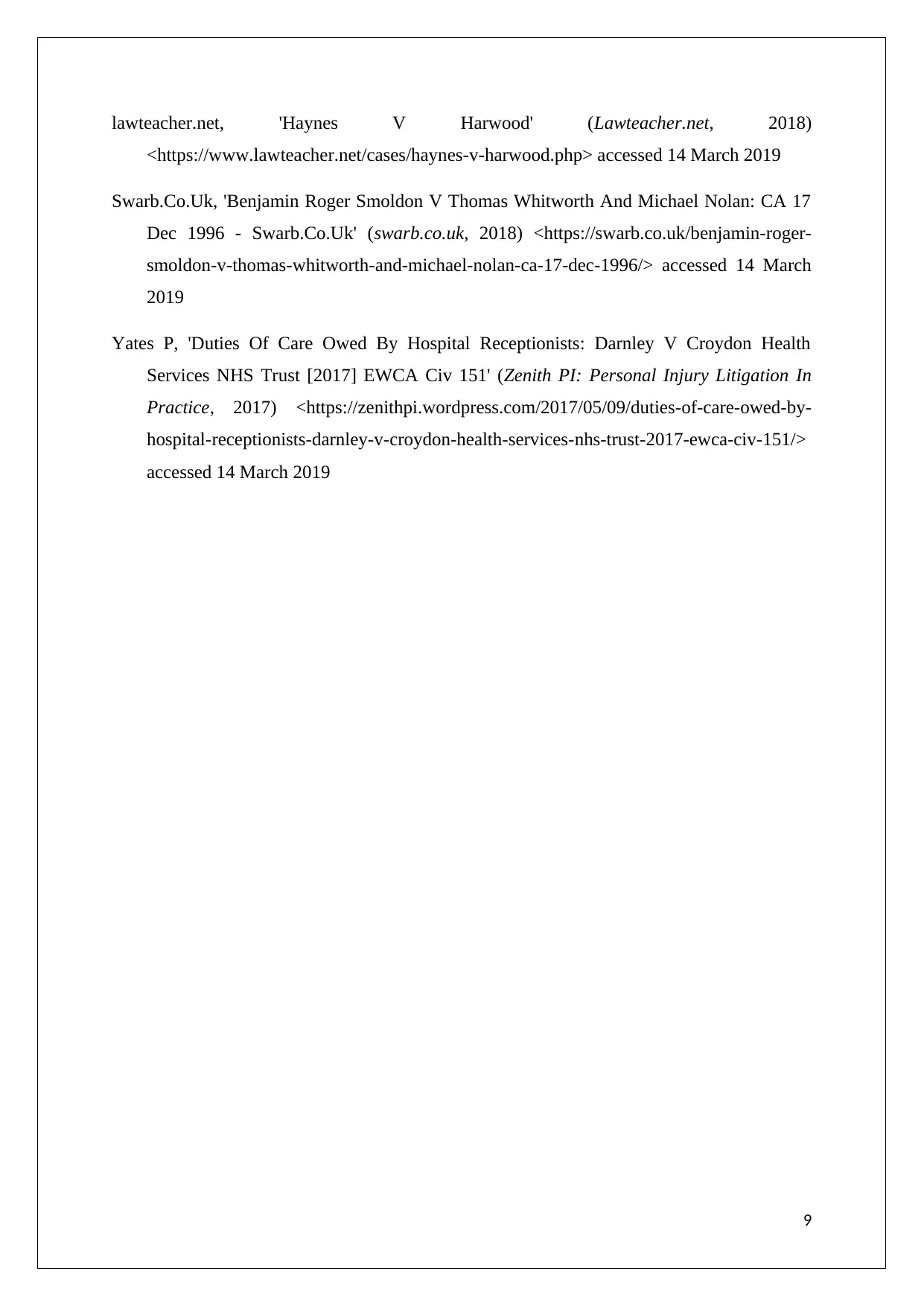
lawteacher.net, 'Haynes V Harwood' (Lawteacher.net, 2018)
<https://www.lawteacher.net/cases/haynes-v-harwood.php> accessed 14 March 2019
Swarb.Co.Uk, 'Benjamin Roger Smoldon V Thomas Whitworth And Michael Nolan: CA 17
Dec 1996 - Swarb.Co.Uk' (swarb.co.uk, 2018) <https://swarb.co.uk/benjamin-roger-
smoldon-v-thomas-whitworth-and-michael-nolan-ca-17-dec-1996/> accessed 14 March
2019
Yates P, 'Duties Of Care Owed By Hospital Receptionists: Darnley V Croydon Health
Services NHS Trust [2017] EWCA Civ 151' (Zenith PI: Personal Injury Litigation In
Practice, 2017) <https://zenithpi.wordpress.com/2017/05/09/duties-of-care-owed-by-
hospital-receptionists-darnley-v-croydon-health-services-nhs-trust-2017-ewca-civ-151/>
accessed 14 March 2019
9
<https://www.lawteacher.net/cases/haynes-v-harwood.php> accessed 14 March 2019
Swarb.Co.Uk, 'Benjamin Roger Smoldon V Thomas Whitworth And Michael Nolan: CA 17
Dec 1996 - Swarb.Co.Uk' (swarb.co.uk, 2018) <https://swarb.co.uk/benjamin-roger-
smoldon-v-thomas-whitworth-and-michael-nolan-ca-17-dec-1996/> accessed 14 March
2019
Yates P, 'Duties Of Care Owed By Hospital Receptionists: Darnley V Croydon Health
Services NHS Trust [2017] EWCA Civ 151' (Zenith PI: Personal Injury Litigation In
Practice, 2017) <https://zenithpi.wordpress.com/2017/05/09/duties-of-care-owed-by-
hospital-receptionists-darnley-v-croydon-health-services-nhs-trust-2017-ewca-civ-151/>
accessed 14 March 2019
9
Paraphrase This Document
Need a fresh take? Get an instant paraphrase of this document with our AI Paraphraser
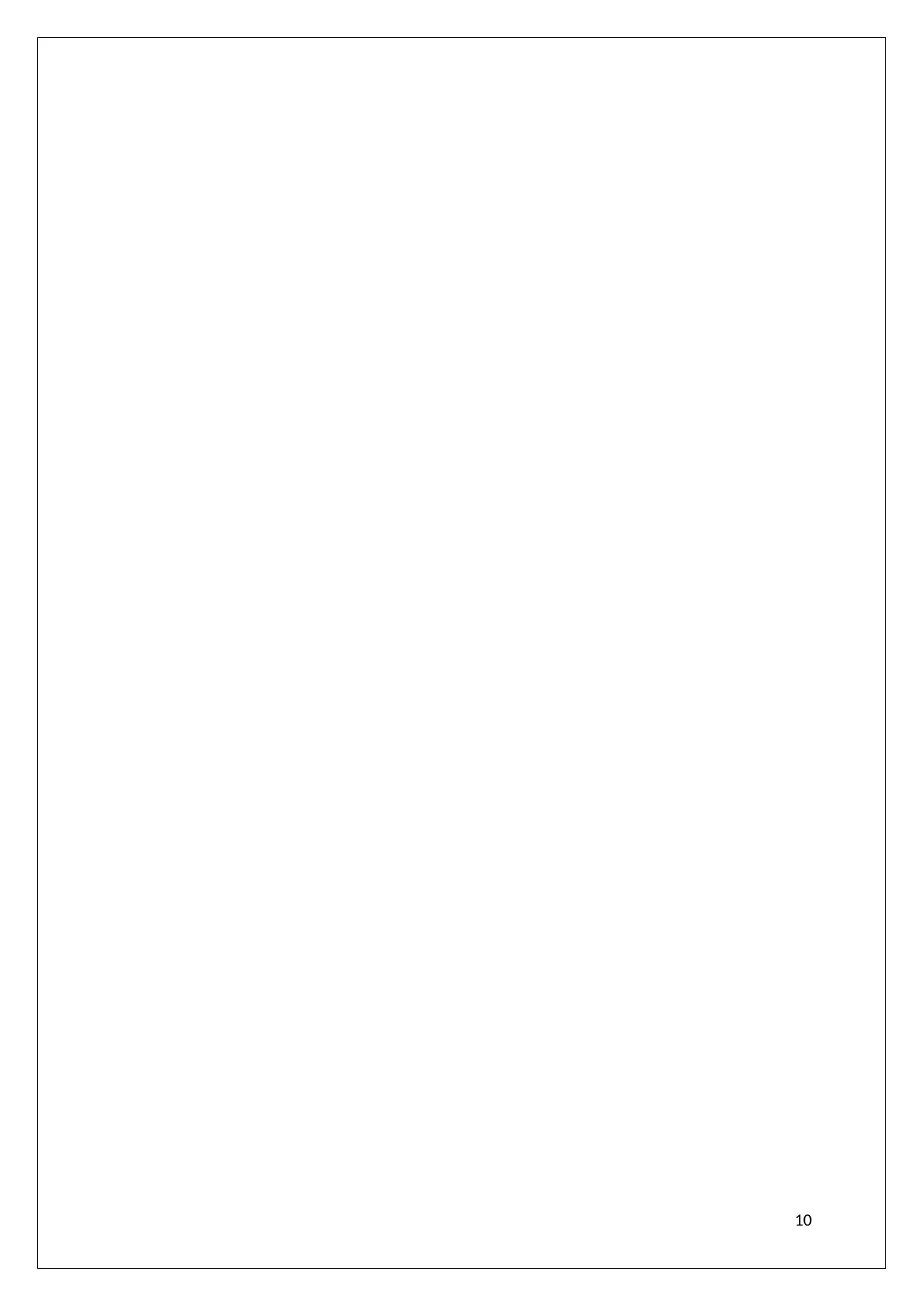
10
1 out of 11
Related Documents
Your All-in-One AI-Powered Toolkit for Academic Success.
+13062052269
info@desklib.com
Available 24*7 on WhatsApp / Email
![[object Object]](/_next/static/media/star-bottom.7253800d.svg)
Unlock your academic potential
Copyright © 2020–2025 A2Z Services. All Rights Reserved. Developed and managed by ZUCOL.




